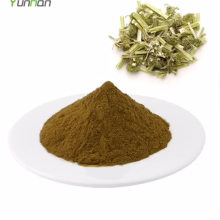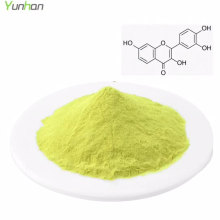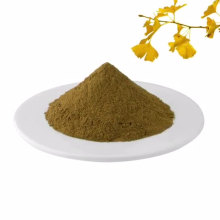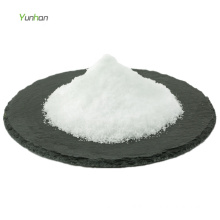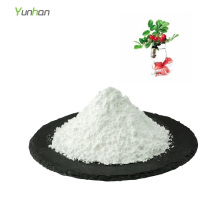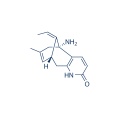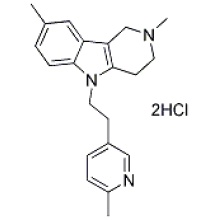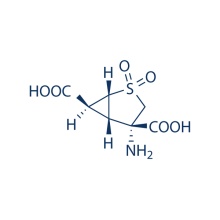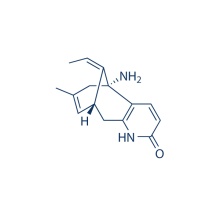(-)-Huperzine A (HupA) 102518-79-6
Product Description
.cp_wz table {border-top: 1px solid #ccc;border-left:1px solid #ccc; } .cp_wz table td{border-right: 1px solid #ccc; border-bottom: 1px solid #ccc; padding: 5px 0px 0px 5px;} .cp_wz table th {border-right: 1px solid #ccc;border-bottom: 1px solid #ccc; padding: 5px 0px 0px 5px;}
Molecular Weight: 242.32 (-)-Huperzine A is a potent, highly specific and reversible inhibitor of acetylcholinesterase (AChE) with Ki of 7 nM, exhibiting 200-fold more selectivity for G4 AChE over G1 AChE. Also acts as an NMDA receptor antagonist. Phase 4.
Biological Activity
(-)-Huperzine A is a novel alkaloid isolated from the Chinese herb
Huperzia serrata. (-)-Huperzine A preferentially inhibits tetrameric
AChE (G4 form). (-)-Huperzine A is more potent than tacrine,
physostigmine, galanthamine, and rivastigmine with respect to inhibition
of AChE activity, whereas HupA is the least potent BuChE inhibitor
among the Inhibitors. (-)-Huperzine A possesses the ability to protect
cells against hydrogen peroxide, β-amyloid protein, glutamate, ischemia
and staurosporine-induced cytotoxicity and Apoptosis. These protective
effects are related to its ability to attenuate oxidative stress,
regulate the expression of apoptotic Proteins Bcl-2, Bax, P53, and
caspase-3, protect mitochondria, upregulate nerve growth factor and its
receptors, and interfere with amyloid precursor protein Metabolism.
(-)-Huperzine A can ameliorate the learning and memory deficiency in
animal models and AD patients. Its potentially beneficial actions
include modification of β-amyloid peptide processing, reduction of
oxidative stress, neuronal protection against apoptosis, and regulation
of the expression and secretion of nerve growth factor (NGF) and NGF
signaling. (-)-Huperzine A significantly inhibits AChE activity in
the cortex, hippocampus, striatum, medial septum, medulla oblongata,
cerebellum, and hypothalamus of rats that are killed 30 min following
the administration of (-)-Huperzine A at several dose levels compared
with the saline control.
Protocol(Only for Reference)
Conversion of different model animals based on BSA (Value based on data from FDA Draft Guidelines)
For example, to modify the dose of resveratrol used for a mouse (22.4 mg/kg) to a dose based on the BSA for a rat, multiply 22.4 mg/kg by the Km factor for a mouse and then divide by the Km factor for a rat. This calculation results in a rat equivalent dose for resveratrol of 11.2 mg/kg.
Chemical Information
Molarity Calculator
Dilution Calculator
Molecular Weight Calculator
Contact us if you need more details on Huperzine A 102518-79-6. We are ready to answer your questions on packaging, logistics, certification or any other aspects about HupA 102518-79-6、102518-79-6. If these products fail to match your need, please contact us and we would like to provide relevant information.
Molecular Weight: 242.32 (-)-Huperzine A is a potent, highly specific and reversible inhibitor of acetylcholinesterase (AChE) with Ki of 7 nM, exhibiting 200-fold more selectivity for G4 AChE over G1 AChE. Also acts as an NMDA receptor antagonist. Phase 4.
Biological Activity
(-)-Huperzine A is a novel alkaloid isolated from the Chinese herb
Huperzia serrata. (-)-Huperzine A preferentially inhibits tetrameric
AChE (G4 form). (-)-Huperzine A is more potent than tacrine,
physostigmine, galanthamine, and rivastigmine with respect to inhibition
of AChE activity, whereas HupA is the least potent BuChE inhibitor
among the Inhibitors. (-)-Huperzine A possesses the ability to protect
cells against hydrogen peroxide, β-amyloid protein, glutamate, ischemia
and staurosporine-induced cytotoxicity and Apoptosis. These protective
effects are related to its ability to attenuate oxidative stress,
regulate the expression of apoptotic Proteins Bcl-2, Bax, P53, and
caspase-3, protect mitochondria, upregulate nerve growth factor and its
receptors, and interfere with amyloid precursor protein Metabolism.
(-)-Huperzine A can ameliorate the learning and memory deficiency in
animal models and AD patients. Its potentially beneficial actions
include modification of β-amyloid peptide processing, reduction of
oxidative stress, neuronal protection against apoptosis, and regulation
of the expression and secretion of nerve growth factor (NGF) and NGF
signaling. (-)-Huperzine A significantly inhibits AChE activity in
the cortex, hippocampus, striatum, medial septum, medulla oblongata,
cerebellum, and hypothalamus of rats that are killed 30 min following
the administration of (-)-Huperzine A at several dose levels compared
with the saline control.
Protocol(Only for Reference)
| In vitro assay of brain acetylcholinesterase | Adult Sprague-Dawley male rats are decapitated, the brain is rapidly dissected on ice into cortex, hippocampus and striatum, and then weighed and homogenized in five volumes of cold 75 mM sodium phosphate buffer, pH 7.4. Homogenates are centrifuged at 13 000 g for 30 min at 4 °C; supernatants used as acetylcholinesterase sources are divided into aliquots and stored at −20 °C. Acetylcholinesterase activity is measured by the principle of the Ellman method. Enzyme samples in 10 mM phosphate buffer, pH 7.5, are incubated 150 s at 37 °C with 0.3 mM acetylthiocholine iodide in the presence of 50 μM tetraisopropyl pyrophosphoramide, a selective inhibitor of butyrylcholinesterase, and 5,5′-dithiobis-(2-nitrobenzoic acid), for color development. Production of the yellow anion of 5-thio-2-nitro-benzoic acid is measured with a SPECTRAmax 96-well plate reader at 412 nm. Protein concentration is measured with the Coomassie brilliant blue protein-binding method using bovine serum albumin as standard. Acetylcholinesterase activity is expressed in international units (1 IU=1 μmol acetylthiocholine hydrolyzed per second) per mg protein. |
|---|
| Animal Models | Male Sprague-Dawley rats | ||
|---|---|---|---|
| Formulation | Saline | ||
| Dosages | 0.1 mg/kg | ||
| Administration | Orally | ||
| Solubility | 30% propylene glycol, 5% Tween 80, 65% D5W, 30 mg/mL | ||
| * Please note that Selleck tests the solubility of all compounds in-house, and the actual solubility may differ slightly from published values. This is normal and is due to slight batch-to-batch variations. | |||
Conversion of different model animals based on BSA (Value based on data from FDA Draft Guidelines)
| Species | Baboon | Dog | Monkey | Rabbit | Guinea pig | Rat | Hamster | Mouse |
| Weight (kg) | 12 | 10 | 3 | 1.8 | 0.4 | 0.15 | 0.08 | 0.02 |
| Body Surface Area (m2) | 0.6 | 0.5 | 0.24 | 0.15 | 0.05 | 0.025 | 0.02 | 0.007 |
| Km factor | 20 | 20 | 12 | 12 | 8 | 6 | 5 | 3 |
| Animal A (mg/kg) = Animal B (mg/kg) multiplied by | Animal B Km |
| Animal A Km |
For example, to modify the dose of resveratrol used for a mouse (22.4 mg/kg) to a dose based on the BSA for a rat, multiply 22.4 mg/kg by the Km factor for a mouse and then divide by the Km factor for a rat. This calculation results in a rat equivalent dose for resveratrol of 11.2 mg/kg.
| Rat dose (mg/kg) = mouse dose (22.4 mg/kg) × | mouse Km(3) | = 11.2 mg/kg |
| rat Km(6) |
Chemical Information
| Molecular Weight (MW) | 242.32 |
|---|---|
| Formula | C15H18N2O |
| CAS No. | 102518-79-6 |
| Storage | 3 years -20℃Powder |
|---|---|
| 6 months-80℃in solvent (DMSO, water, etc.) | |
| Synonyms | |
| Solubility (25°C) * | In vitro | DMSO | 0.66 mg/mL (2.72 mM) |
|---|---|---|---|
| Water | <1 mg/mL ( | ||
| Ethanol | <1 mg/mL ( | ||
| In vivo | 30% propylene glycol, 5% Tween 80, 65% D5W | 30 mg/mL | |
| * <1 mg/ml means slightly soluble or insoluble. * Please note that Selleck tests the solubility of all compounds in-house, and the actual solubility may differ slightly from published values. This is normal and is due to slight batch-to-batch variations. | |||
| Chemical Name | (5R,9R,11E)-5-amino-11-ethylidene-5,6,9,10-tetrahydro-7-methyl-5,9-methanocycloocta[b]pyridin-2(1H)-one |
|---|
Molarity Calculator
Dilution Calculator
Molecular Weight Calculator
Contact us if you need more details on Huperzine A 102518-79-6. We are ready to answer your questions on packaging, logistics, certification or any other aspects about HupA 102518-79-6、102518-79-6. If these products fail to match your need, please contact us and we would like to provide relevant information.
Product Categories : Neuronal Signaling > GluR Inhibitor
Other Products
Hot Products
Astragaloside AChlortetracycline HCl 64-72-2Paclitaxel 33069-62-4Dexamethasone Acetate 1177-87-3Dinaciclib (SCH727965) 779353-01-4CHIR-124 405168-58-3Ro3280 1062243-51-9TAME 901-47-3CCG-1423 285986-88-110058-F4 403811-55-2Dabigatran (BIBR 953) 211914-51-1H 89 2HCl 130964-39-5T0901317 293754-55-9Aprepitant 170729-80-3Turofexorate Isopropyl (XL335) 629664-81-9BMS-378806 357263-13-9


